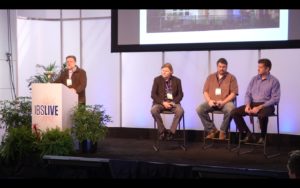 A panel of three prominent executives in the home building industry emphasized the need to continue innovating even as the housing recovery continues.
A panel of three prominent executives in the home building industry emphasized the need to continue innovating even as the housing recovery continues.
“Not everything is selling,” said Michael Woodley, principal of the Woodley Architectural Group with offices in Denver and Southern California. “Today’s buyers are much more discriminating. They are only buying the best homes in the best locations.”
Buyers are looking for a better lifestyle fit than ever before, said Tom Wade, a principal with Palo Duro Homes, based in Albuquerque, N.M. Wade just spend time with a focus group of female, family buyers in their late 30s, trying to get a better handle on their aspirations. Rather than deciding what we want to build, “we need a better understanding of what they want to buy,” he said.
C.R. Herro, vice president of sustainability for Meritage Homes, noted that some Energy Star builders may drop out of the program, now that the requirements have stiffened to require a thermal break in the building envelopment. “That’s a move that some large production builder may not be willing to make,” said Herro, showing a prototype home using structural insulated panels that Meritage has under construction in Phoenix.
An added benefit of innovation, the panelists agreed, is that it attracts the best people to your company, a recruitment advantage that’s especially important at a time when builders and architects report trouble luring people back into the fold.
The panelists generally agreed that a willingness to do things differently, to innovate in the face of flagging demand, got their companies through the recession. In the case of Woodley, that meant designing more contemporary production homes, such as the Space program for Shea Homes and the Lime Series for Infinity Homes. Both programs outsold the competition by tapping into an unmet demand.
Herro developed Meritage’s deconstructed model homes, which featured behind-the-wall vignettes that demonstrated how technology works inside its homes. Displays demonstrated sometimes interactively how items such as heat recovery ventilators and low-e windows actually work. The displays created a strong image for Meritage as a high-performance home builder.
Wade and his father counterintuitively decided, after the housing recession arrived, to add more to their basic homes rather than de-feature them. In addition to building to Energy Star requirement, they build to the EPA’s WaterSense and Indoor airPLUS programs. He’s finding that Hepa filters for cleaner indoor air really resonates with his 30-something female buyers. Wade said his company’s next move may be into mini-split air conditioning systems that don’t require ductwork.
Woodley said that one of the challenges for architects and builders in the future may be to uncomplicated the home. Many of the advances that high-performance homes have made —better energy efficiency, cleaner indoor air — comes at a price that may become too steep for average buyers. A simple design that is properly oriented on the lot that uses natural heating and cooling and eliminates excessive wiring and ductwork could be addressed through architecture.